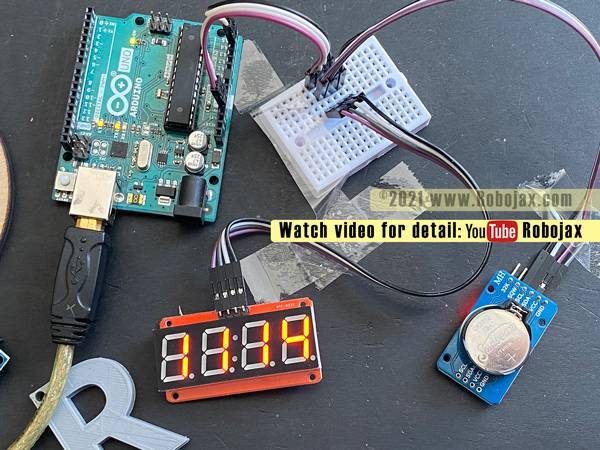Build Simple digital clock using Arduino DS3231
Build digital clock using HT16K33 with DS3231 with Arduino
This code is to connect three or more MLX90614 to Arduino.
The sensor is explained, datasheet is reviewed, wiring and code shown and demonstrated by measuring surface temperature, then using heat gun temperature is measured then temperature of a heater is measured. Arduino code is provided. See link below.
If you need to connect only MLX90614 to the same Arduino, See the code here
This code has not been tested. Study it fully and you will understand how it works and you can find the issue and fix it.
Libraries needed for this project
1-DS3231 RTClib library (and watch video instruction)2-HT16K33 Library (and watch video instruction) Both libraries are available for download from links below.
Chapters in this video
- 00:35 Introduction
- 03:21 Wiring explained
- 05:09 Arduino code fully explained
- 17:23 Demonstration of all features
Digital clock with HT16K33 and DS3231: main

Click on image to enlarge
Resources for this sketch
- Introduction to DS3231 Code and Video
- Introduction to HT16K33 4 digit seven segment
- HT16K33 Library (from Robojax.com)
- HT16K33 Library (from GitHub)
- HT16K33 Datasheet(pdf)
- Download DS3231 Library zip file (from robojax.com)
- Download DS3231 Library zip file (from GetHub.com)
- DS3231 Datasheet (pdf)
- Adafruit MLX90614 Library (from Robojax)
- Melexis MLX90614 Datasheet (pdf)
- Melexis Website Official Web Site
- Robojax Crash Course on Arduino: Learn Arduino in 30 Minutes (code and video)
- Robojax Arduino Course on Udemy
- Get Early Access to my videos via Patreon
/*
* file: DS3231_HT16K33_clock_display
* Digital clock using DS3231 Real Time clock module and Arduino
* Displays time on 4 digits seven segment dispaly HT16K33
* Used DW3231 library and HT16K33 library below
* watch video instruction:
*
* Must watch two videos
* Introduction to DS3231:https://youtu.be/7hBtXdoaAOY
* Introduction to HT16K33:https://youtu.be/tEwWsbHQA5Q
*
* Written by Ahmad Shamshiri on Feb 07, 2021 in Ajax, Ontario, Canada
* www.Robojax.com
*
*
* This code is "AS IS" without warranty or liability. Free to be used as long as you keep this note intact.*
* This code has been download from Robojax.com
This program is free software: you can redistribute it and/or modify
it under the terms of the GNU General Public License as published by
the Free Software Foundation, either version 3 of the License, or
(at your option) any later version.
This program is distributed in the hope that it will be useful,
but WITHOUT ANY WARRANTY; without even the implied warranty of
MERCHANTABILITY or FITNESS FOR A PARTICULAR PURPOSE. See the
GNU General Public License for more details.
You should have received a copy of the GNU General Public License
along with this program. If not, see <https://www.gnu.org/licenses/>.
DS3231: Real-Time Clock. Simple example
Read more: www.jarzebski.pl/arduino/komponenty/zegar-czasu-rzeczywistego-rtc-ds3231.html
GIT: https://github.com/jarzebski/Arduino-DS3231
Web: http://www.jarzebski.pl
(c) 2014 by Korneliusz Jarzebski
HT16k33 library
// AUTHOR: Rob Tillaart
// VERSION: 0.1.0
// PURPOSE: demo
// URL: http://www.adafruit.com/products/1002
// URL: https://github.com/RobTillaart/HT16K33
*/
#include <Wire.h>
#include <DS3231.h>
DS3231 clock;
RTCDateTime dt;
#include "HT16K33.h"
HT16K33 seg(0x70);//initialize the display with 0x70 I2C address
//watch video for settings details and demo https://youtu.be/XGsT-0P0gMU
bool showSecond = true;//show or hide seconds. set to false to not show
unsigned int secondDisplayEvery=5000;//show seconds every 10 seconds
unsigned int secondBlinkCount=6;//show 3 blinks of second
unsigned int secondDisplayDuration =20000;//for how long seconds should be shown (in milliseonds)
bool showLeadingZero =true;
bool showSecondNoBlink=true;//just count senconds no blink
unsigned long rememberTime = millis();
void showSeconds1();
void showSeconds2();
void setup()
{
Serial.begin(9600);
// Initialize DS3231
Serial.println("Robojax Digitla Clock");
Serial.println("using DS3231 and HT16K33");
clock.begin();
seg.begin();
Wire.setClock(100000);
seg.displayOn();
seg.setDigits(4);
seg.displayTest(1);
seg.displayOff();
delay(50);
seg.displayOn();
seg.brightness(10);//set brightness from 1-15
// Set sketch compiling time
clock.setDateTime(__DATE__, __TIME__);
// Manual (YYYY, MM, DD, HH, II, SS
//clock.setDateTime(2021, 4, 13, 8, 01, 00);
}
void loop()
{
(showLeadingZero)? seg.setDigits(4) : seg.setDigits(3);
//watch video for details
dt = clock.getDateTime();
printTime();//print time on serial monitor
seg.displayTime(dt.hour,dt.minute);
seg.displayColon(1);
delay(500);
seg.displayColon(0);
delay(500);
(showSecondNoBlink)? showSeconds2() : showSeconds1();
}//
/*
*
* @brief shows seconds on HT16K33 display
* with blinking
* @param none
* @return no return value
* written Feb 06, 2021 by Ahmad Shamshiri
* www.robojax.com
*/
void showSeconds1()
{
int count = secondBlinkCount;
if(showSecond){
if(millis() - rememberTime > secondDisplayEvery)
{
while(count>=0)
{
dt = clock.getDateTime();
count -=1;
seg.setDigits(2);
seg.displayInt(dt.second);
delay(500);
seg.displayOff();
delay(500);
seg.displayOn();
rememberTime = millis() ;
}// while end
}//if
}//if showSecond is true
}//showSecond() end
/*
*
* @brief shows seconds on HT16K33 display
* without blinking.
* @param none
* @return no return value
* written Feb 06, 2021 by Ahmad Shamshiri
* www.robojax.com
*/
void showSeconds2()
{
int count = secondDisplayDuration;
if(showSecond){
if(millis() - rememberTime > secondDisplayEvery)
{
while(count>=0)
{
dt = clock.getDateTime();
count -=50;
seg.setDigits(2);
seg.displayInt(dt.second);
delay(50);
rememberTime = millis() ;
}// while end
}//if
}//if showSecond is true
}//showSeconds2() end
/*
*
* @brief prints time on serial monitor
* @param none
* @return no return value
* written Feb 06, 2021 by Ahmad Shamshiri
* www.robojax.com
*/
void printTime()
{
Serial.print("Raw data: ");
Serial.print(dt.year); Serial.print("-");
Serial.print(dt.month); Serial.print("-");
Serial.print(dt.day); Serial.print(" ");
Serial.print(dt.hour); Serial.print(":");
Serial.print(dt.minute); Serial.print(":");
Serial.print(dt.second); Serial.println("");
}//printTime() end
